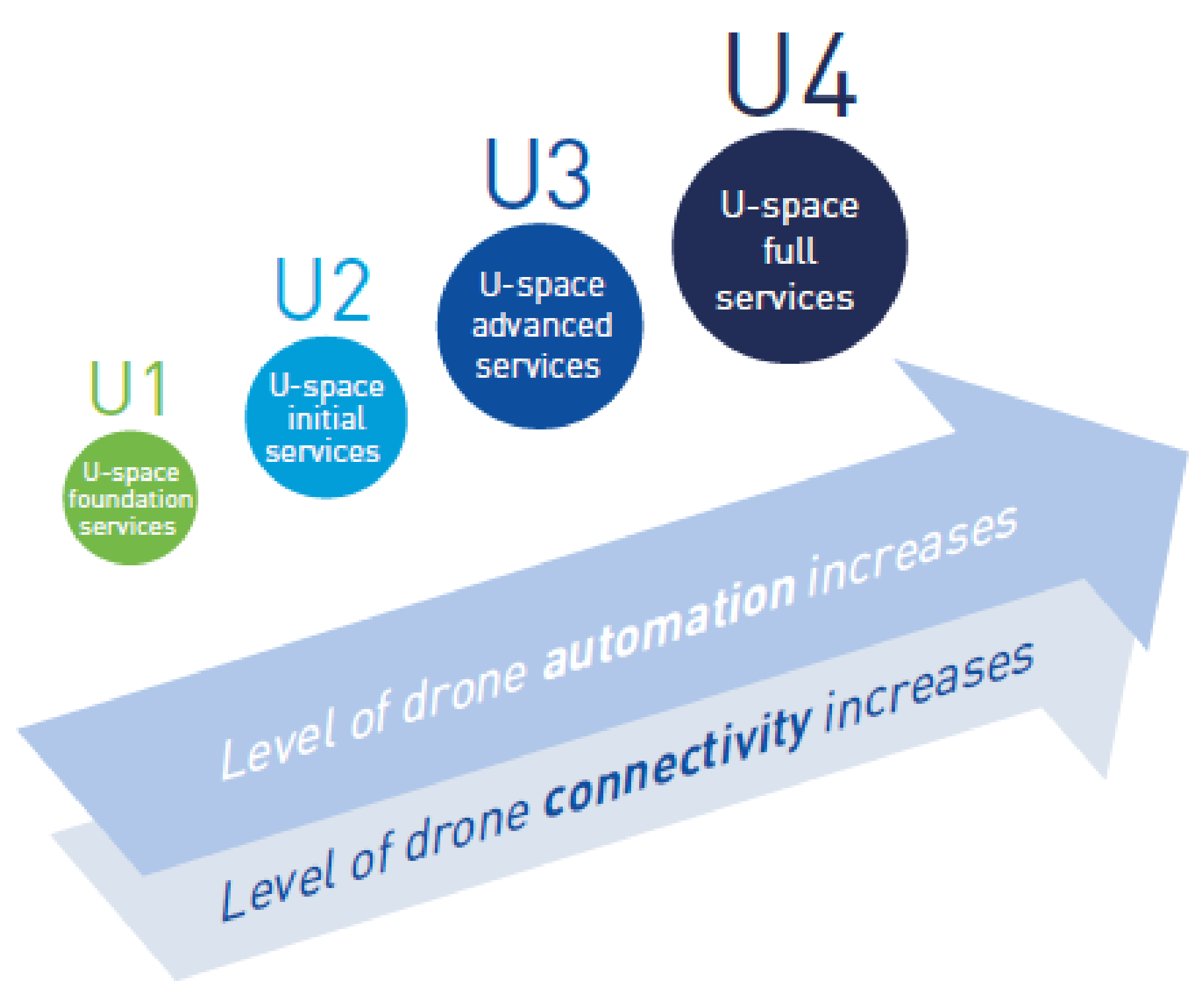EuroDRONE, a European Unmanned Traffic Management Testbed for U-Space †
Abstract
:1. Introduction
2. Europe’s UTM Framework: ‘U-Space’
U-Space
3. EuroDRONE UTM Architecture
3.1. Vehicle to Infrastructure (V2I)
3.2. EuroDRONE Operational Sequence
3.3. EuroDRONE Deconfliction Strategy
3.4. Sense and Avoid Approach
4. EuroDRONE Flight Trials
- Scenario 1, simple, all over Messolonghi airport, some drones in VLOS in cylinder (can be multiples, but for some of them we just submit cylinder; we can report positions via DronAssistant), some drones in BVLOS but flying around the airport only (DronAssistant); this scenario is for surveying, monitoring, taking images and videos in general;
- Scenario 2, over Messolonghi, show Detect and Avoid, with BVLOS and DroNav (at least 2) plus as many VLOS as in the first scenario; this scenario is for surveying, monitoring, taking images and videos in general;
- Scenario 3, from Messolonghi city to Messolonghi airport, can be as the two previous, but we add a VTOL drone from ELTA post office in the city to landing on the airport; show B2B small-parcel express logistics (e.g., Figure 11);
4.1. Demonstration Objectives
- The demonstration occurred in a real-life environment, using actual, non-segregated airspace.
- Demonstrations included both types of operations BVLOS and VLOS.
- The drones used for the demonstrations were fully automated, mixed with manually operated drones in VLOS.
- The demonstration included U1 services and assessed their compatibility with U2 services.
- Demonstrations included at least U-space U2 core services and associated drone capabilities.
- Demonstrations included realistic missions corresponding to anticipated business opportunities.
- Demonstrations included at least five drones operating simultaneously in the same geographical area.
- Demonstrations of some U-space enhanced services (U3) (through the DronAssistant).
- Drone operations in controlled airspace especially close to airports (including airspace design and procedural interface with ATC).
- Inclusion of operations performed by sport aviation/general aviation or rotorcraft in the flying demonstration(s).
- Inclusion of leisure drone user(s) in demonstration activities to show that the general public can pursue their hobbies in this shared environment and benefit from some of the U- space services.
- Use of Vehicle-to-Infrastructure communication (V2I) communication as the ability for drones to share information with infrastructure components (through DronAssistant).
- Use of Vehicle-to-Vehicle (V2V) communication as the ability for drones to communicate information to each other (among DronAssistants).
- Use of Detect and Avoid (DAA) solution, as the ability for drones to detect cooperative conflicting traffic, or other hazards, and take the appropriate action to comply with the applicable rules of flight (DronAssistant Category B).
4.2. Demonstration No. 1
- A mission was created for a flight in the area of Messolonghi airport, in standard ArduPilot text format. The path was surveyed for any obstacles.
- Gaia was transported to the take-off position and pre-flight tests were conducted.
- The mission was uploaded to the DroNav platform, which tested for any conflicts.
- After approval, the mission was automatically uploaded to the UAV from DroNav through DA, when the flight time slot was reached.
- The area (Messolonghi Airport) was notified that the flight was about to begin.
- The operator of the UAV pressed the take-off button on the DA and, 15 s later, the flight began carrying out the uploaded mission.
- The UAV reported through the DA during the entire flight at 1 sec intervals.
- After the landing of the UAV, the area (Messolonghi Airport) was notified that the flight was concluded.
- Testing the network coverage in the demonstrations area
- Manual flight of each individual drone for security reasons
- Manual take-offs and landings for testing
- Autonomous VLOS operations in the vicinity of the airport of Messolonghi
- Continuous trajectory tracking
- Use of both a hexacopter (GAIA) and a VTOL (Babyshark) UAV Successful mission of delivering the attached load for the VLOS operation
- FLARM technologies were tested along with V2V communication and collision avoidance capabilities.
- Flights to test the endurance of the UAVs
- Collision avoidance was tested in simulation scenarios using FLARM simulation
4.3. Demonstration No. 2
- Coordination with ATC
- Continuous flight status monitoring through Dronav platform (with RF visual monitoring for backup)
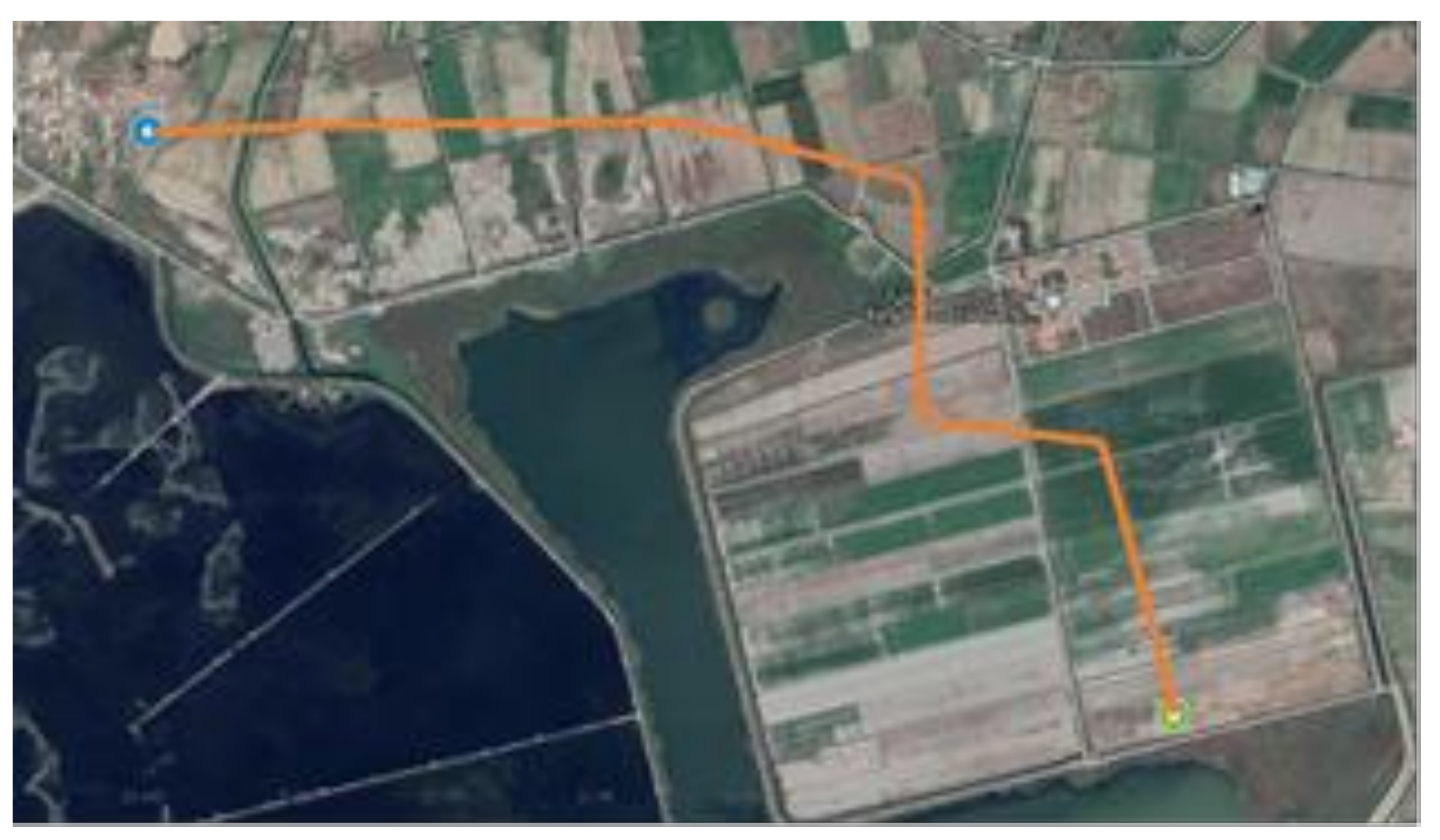
- Scenario 2: same as Scenario 1, but with the addition of a cooperative General Aviation intruder (or surrogate, e.g., manually operated drone in VLOS with cooperative transmitter as in General Aviation).
- Scenario 3: a 5 km-long highly automated BVLOS mission from Messolonghi City (urban area) to Messolonghi Airport, demonstrating a small parcel delivery commercial user case and interaction with an urban environment (Figure 21).
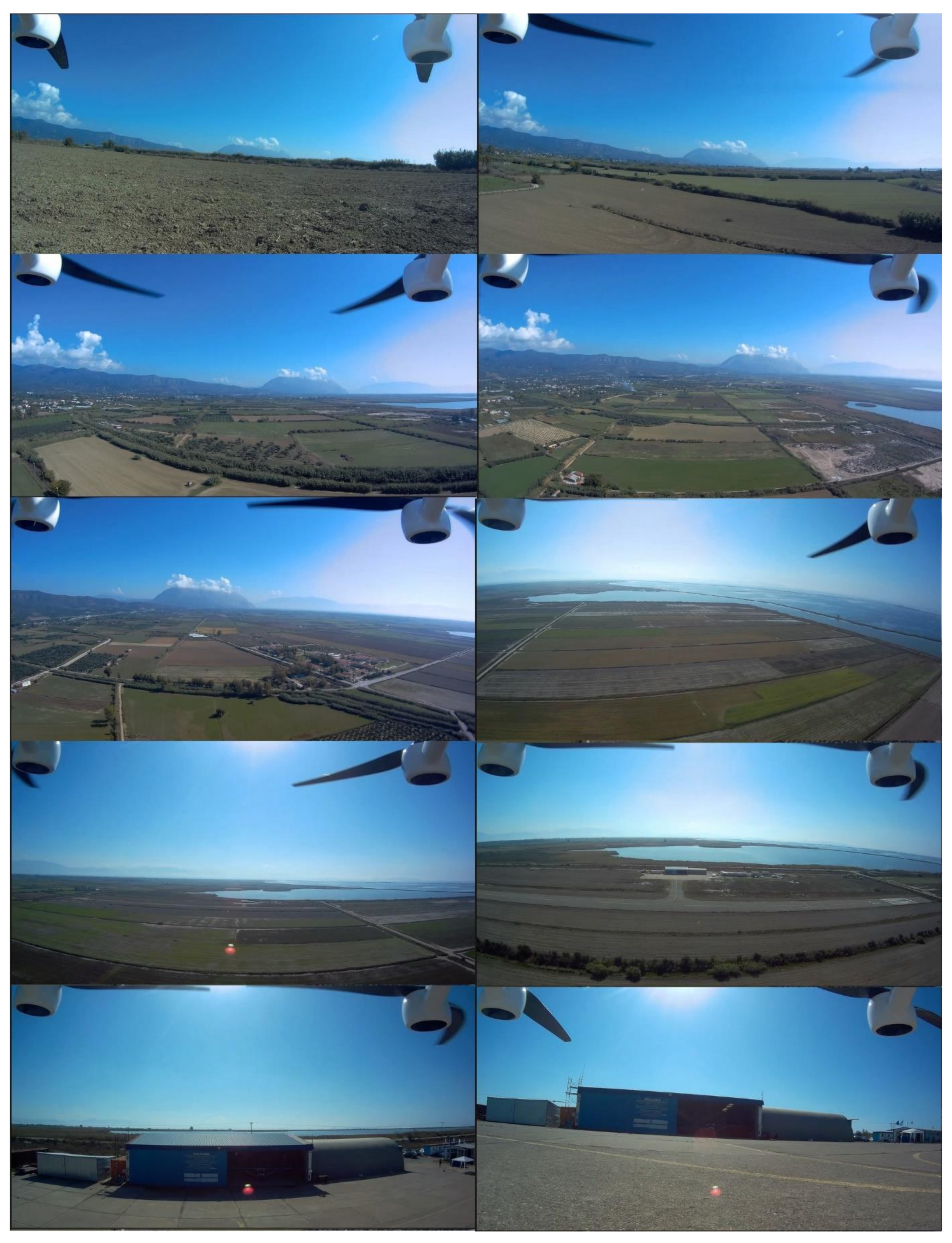
4.4. Demonstration Recommendations
- Availability of robust mobile network (LTE4G/3G) coverage, in particular in UAV and UTM flight corridors (>98% coverage)
- Requirement of detailed maps of the geographical areas of operation (1:50,000 or 1:100,000)
- Robustness of critical hardware such as sense-and-avoid sensors, which are at a low TRL (e.g., FLARM sensors required extensive calibration and had many software challenges), drones (platform reliability, ground station RF links)
- Requirements of RADAR sensors for drone tracking, in particular for UAV flight corridors
- Increased autonomous UTM-ATC links and operations
5. Conclusions
Author Contributions
Funding
Institutional Review Board Statement
Informed Consent Statement
Data Availability Statement
Acknowledgments
Conflicts of Interest
Abbreviations
| ATM | Air Traffic Management |
| ATC | Air Traffic Control |
| BVLOS | Beyond Visual Line of Sight |
| CA | Collision Avoidance |
| CAA | Civil Aviation Authority |
| APF | Artificial Potential Field |
| DAA | Detect & Avoid |
| DGC | Differential Geometry Concept |
| EASA | European Aviation Safety Agency |
| GA | General Aviation |
| GNSS | Global Navigation Satellite System |
| HCAA | Hellenic Civil Aviation Authority |
| ICAO | International Civil Aviation Organization |
| NASA | National Aeronautics and Space Administration |
| NFZ | No Fly Zone |
| PSO | Particle Swarm Optimisation |
| QoS | Quality of Service |
| ROS | Robot Operating System |
| SAR | Search and Rescue |
| SESAR | Single European Sky ATM Research |
| TD | Tactical Deconfliction |
| UAS | Unmanned Aircraft System |
| USM | U-space Service Manager |
| UTM | Unmanned aerial system Traffic Management |
| V2V | Vehicle to Vehicle |
| V2I | Vehicle to Infrastructure |
| VLL | Very Low Level |
| VLOS | Visual Line of Sight |
References
- SJU. European Drones Outlook Study, Unlocking the Value for Europe (November 2016); SESAR Joint Undertaking: Brussels, Belgium, 2016. [Google Scholar]
- SJU. Blueprint on U-Space; SESAR Joint Undertaking: Brussels, Belgium, 2018. [Google Scholar]
- EUROCONTROL. UAS ATM Integration Operational Concept; EUROCONTROL: Brussels, Belgium, 2018. [Google Scholar]
- SJU. European ATM Master Plan; SESAR Joint Undertaking: Brussels, Belgium, 2015. [Google Scholar]
- Barrado, C.; Boyero, M.; Brucculeri, L.; Ferrara, G.; Hately, A.; Hullah, P.; Martin-Marrero, D.; Pastor, E.; Rushton, A.P.; Volkert, A. U-Space Concept of Operations: A Key Enabler for Opening Airspace to Emerging Low-Altitude Operations. Aerospace 2020, 7, 24. [Google Scholar] [CrossRef] [Green Version]
- SESAR U-Space Projects. Available online: https://www.sesarju.eu/node/3202 (accessed on 1 December 2021).
- SESAR Drone Outlook Study. 2016. Available online: https://www.sesarju.eu/sites/default/files/documents/reports/European_Drones_Outlook_Study_2016.pdf (accessed on 14 May 2021).
- EU Aviation Strategy. Available online: https://ec.europa.eu/transport/modes/air/aviation-strategy/innovation (accessed on 14 May 2021).
- Declaration, W. Drones as a leverage for jobs and new business opportunities. In Proceedings of the Conference on Drones as A Leverage for Jobs and New Business Opportunities, Warsaw, Poland, 23–24 November 2016. [Google Scholar]
- Federal Aviation Administration. Unmanned Aircraft Systems (UAS) Traffic Management (UTM) Concept of Operations (v2.0). 2020. Available online: https://www.nasa.gov/sites/default/files/atoms/files/2020-03-faa-nextgen-utm_conops_v2-508_1.pdf (accessed on 1 February 2022).
- National Aeronautics and Space Administration (2018) UTM UAS Service Supplier Development—Sprint 2 Toward Technical Capability Level 4 (NASA/TM-2018-220050). NASA Ames Research Center. Available online: https://utm.arc.nasa.gov/docs/2018-UTM_UAS_TCL4_Sprint2_Report_v2.pdf (accessed on 1 February 2022).
- Oosedo, A.; Hattori, H.; Yasui, I.; Harada, K. Unmanned Aircraft System Traffic Management (UTM) Simulation of Drone Delivery Models in 2030 Japan. J. Robot. Mechatron. 2021, 33, 348–362. [Google Scholar] [CrossRef]
- Global UTM Association. Designing UTM for Global Success; Technical Report; Global UTM Association: Lausanne, Switzerland, 2020. [Google Scholar]
- Lappas, V.; Zoumponos, G.; Kostopoulos, V.; Shin, H.Y.; Tsourdos, A.; Tantarini, M.; Shmoko, D.; Munoz, J.; Amoratis, N.; Maragkakis, A.; et al. EuroDRONE, A European UTM Testbed for U-Space. In Proceedings of the 2020 International Conference on Unmanned Aircraft Systems (ICUAS), Athens, Greece, 1–4 September 2020; pp. 1766–1774. [Google Scholar] [CrossRef]
- Dronsystems Company Website. Available online: https://www.dronsystems.com (accessed on 1 February 2022).
- Cooperative Departures for a Competitive ATM Network Service—PARTAKE, SJU SESAR Grant Agreement ID: 699307. Available online: https://www.sesarju.eu/node/3182 (accessed on 1 February 2022).
- Ramos, J.J.; Schefers, N.; Radanovic, M.; Piera, M.A.; Folch, P. A Constraint Programming Model with Time Uncertainty for Cooperative Flight Departures. Available online: https://pdfs.semanticscholar.org/be0f/1b0880b6eb560aefd716698ceaaaa756d539.pdf (accessed on 9 February 2022).
- Lee, H.I.; Shin, H.S.; Tsourdos, A. UAV Collision Avoidance Considering No-Fly-Zones. IFAC-Pap. Line 2020, 53, 14748–14753. [Google Scholar] [CrossRef]
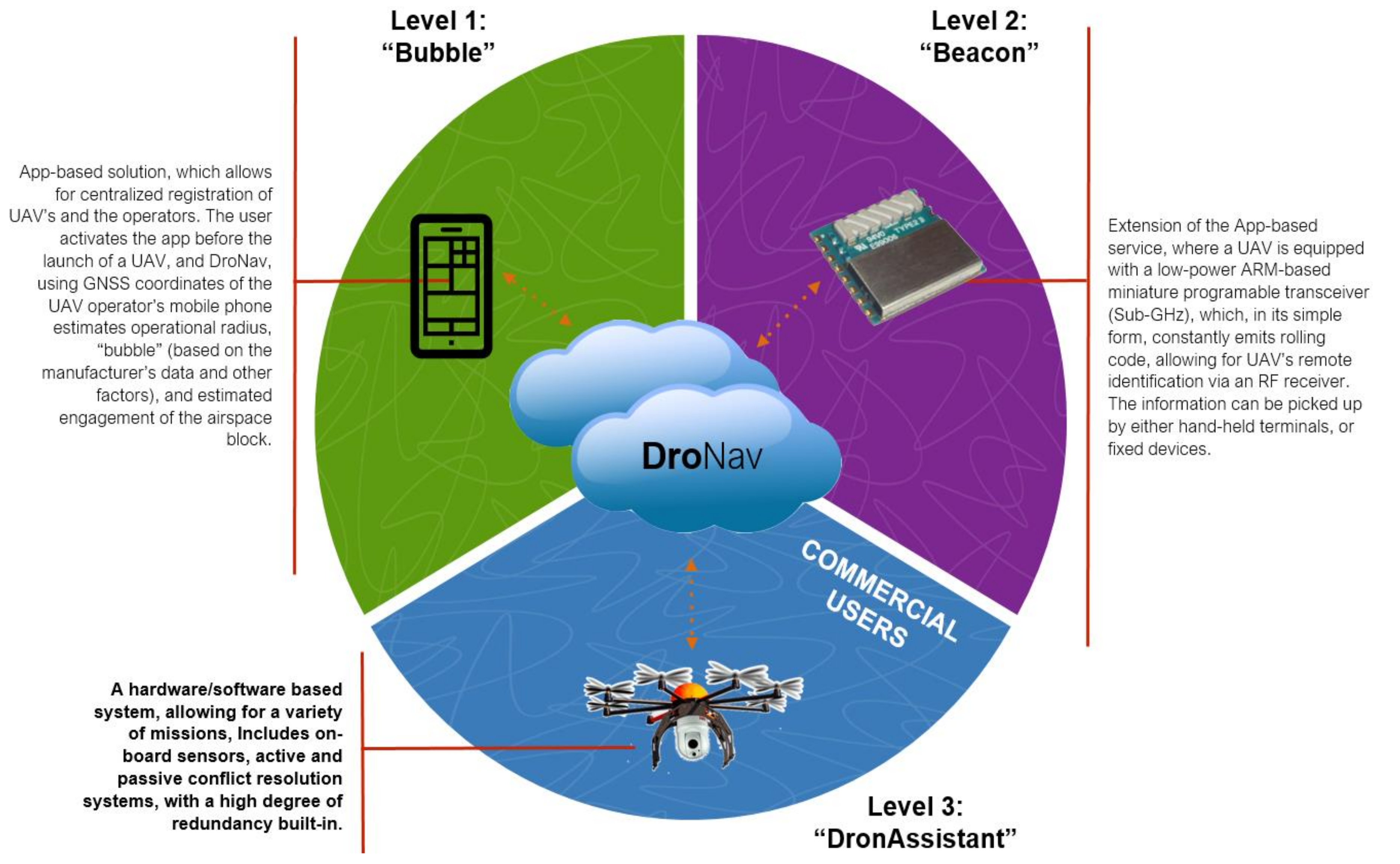
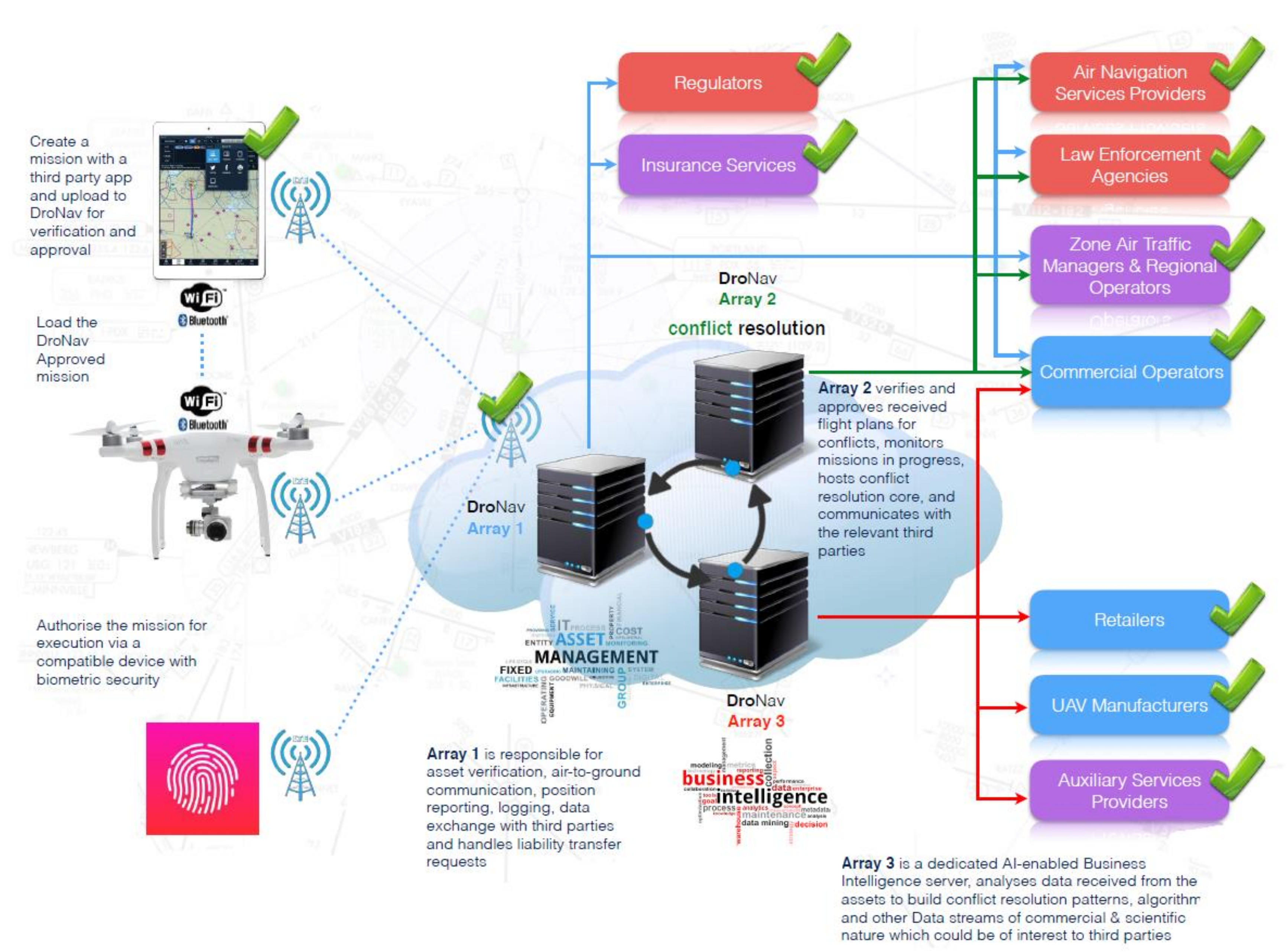
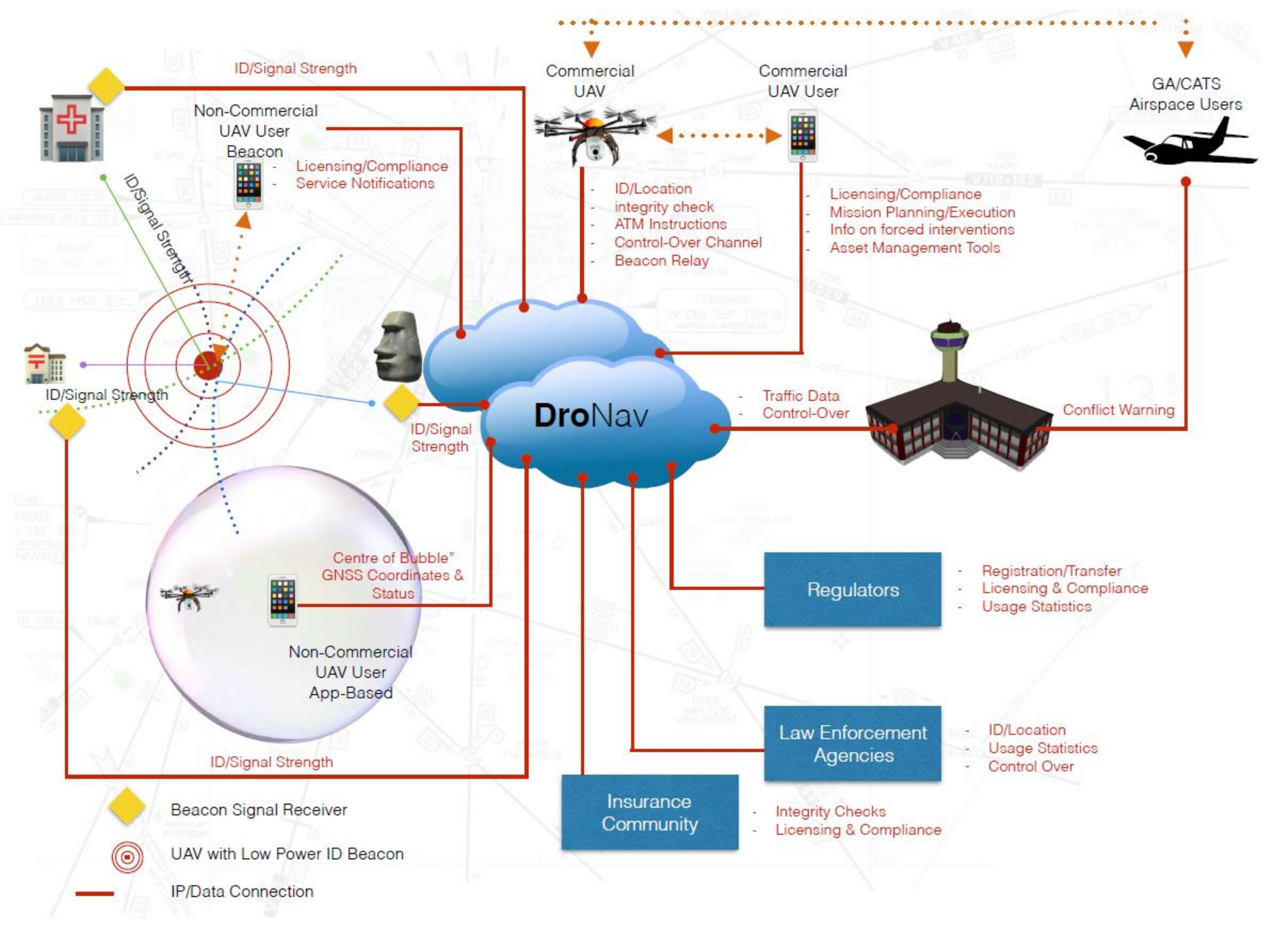
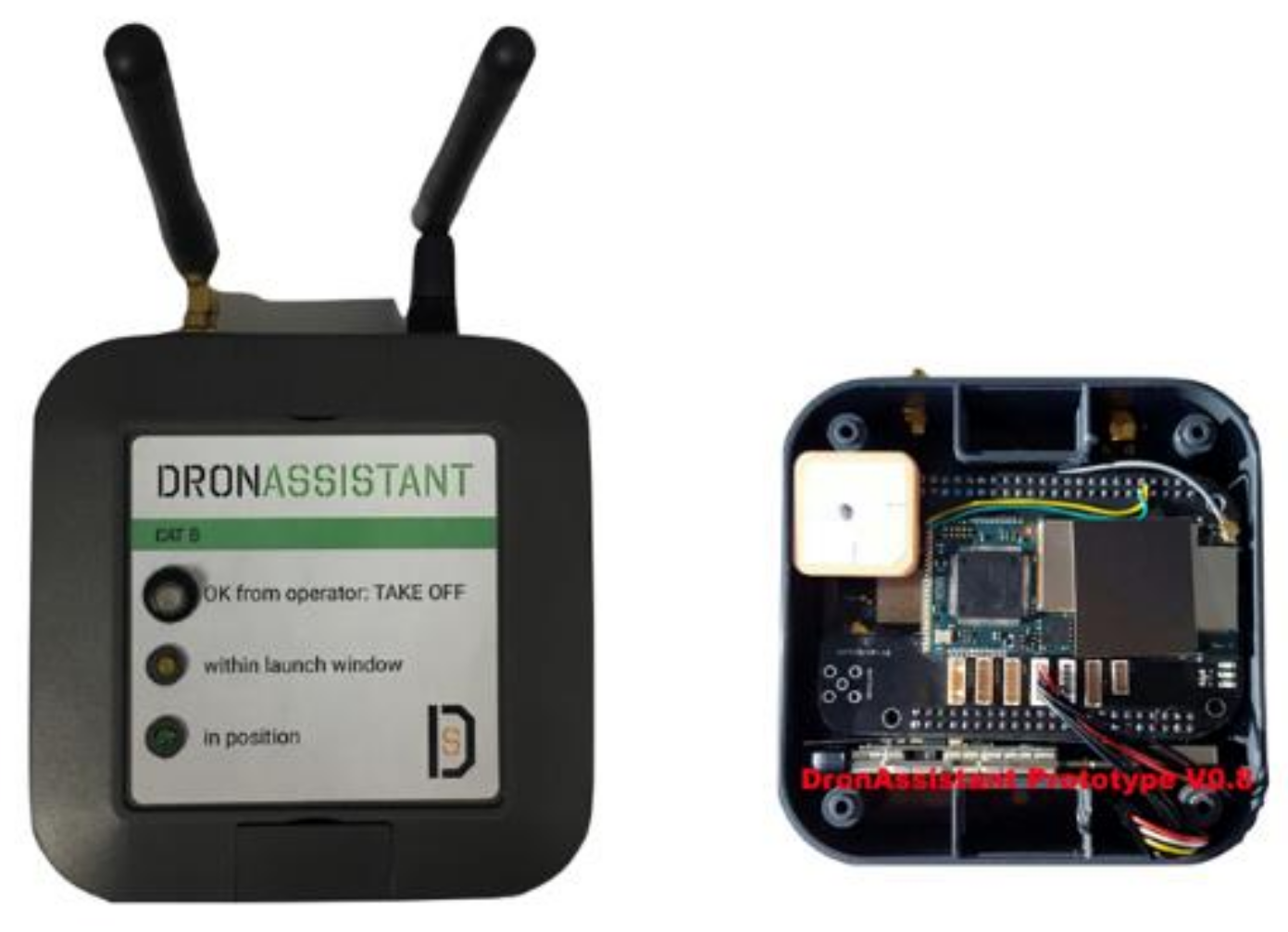
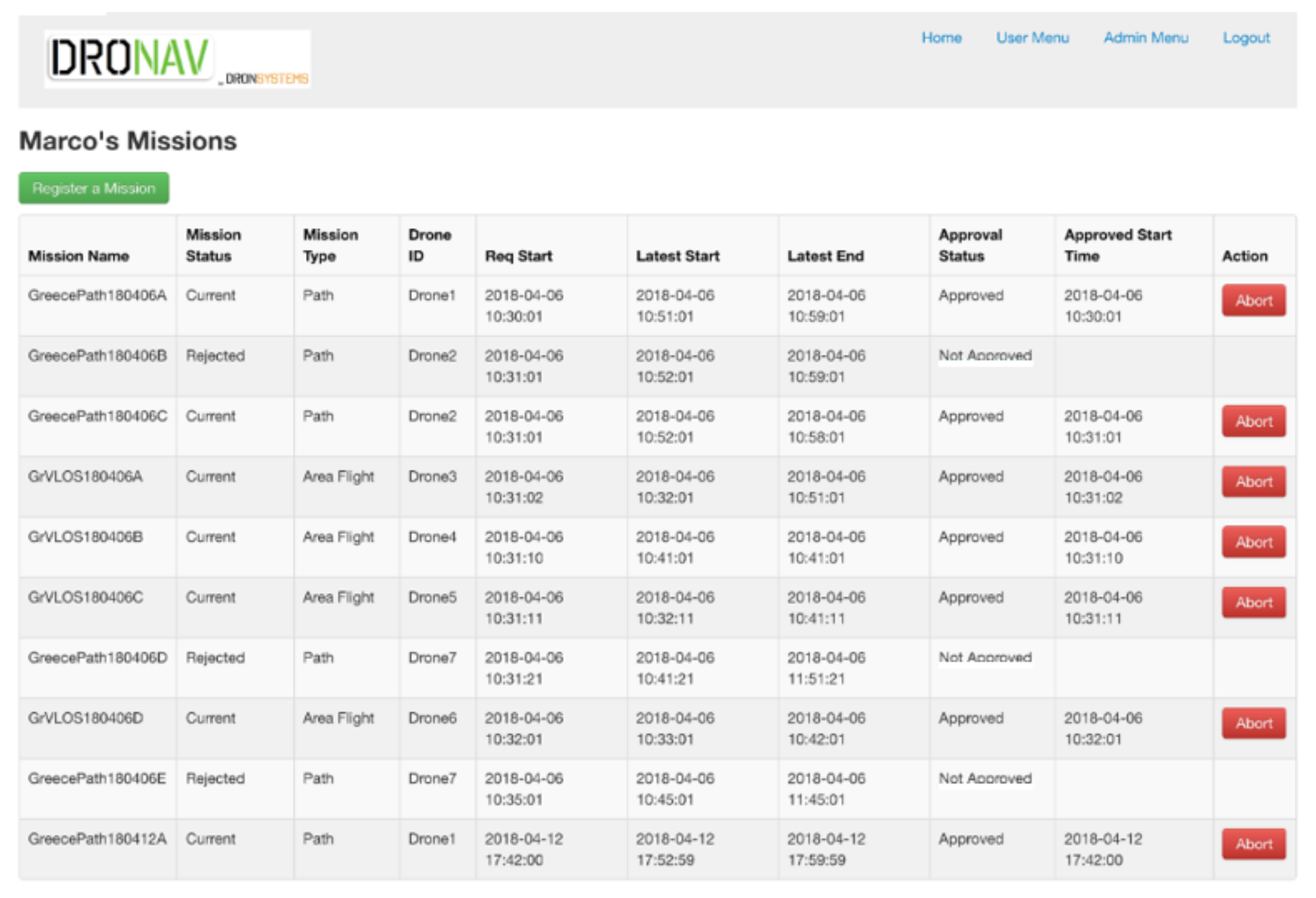
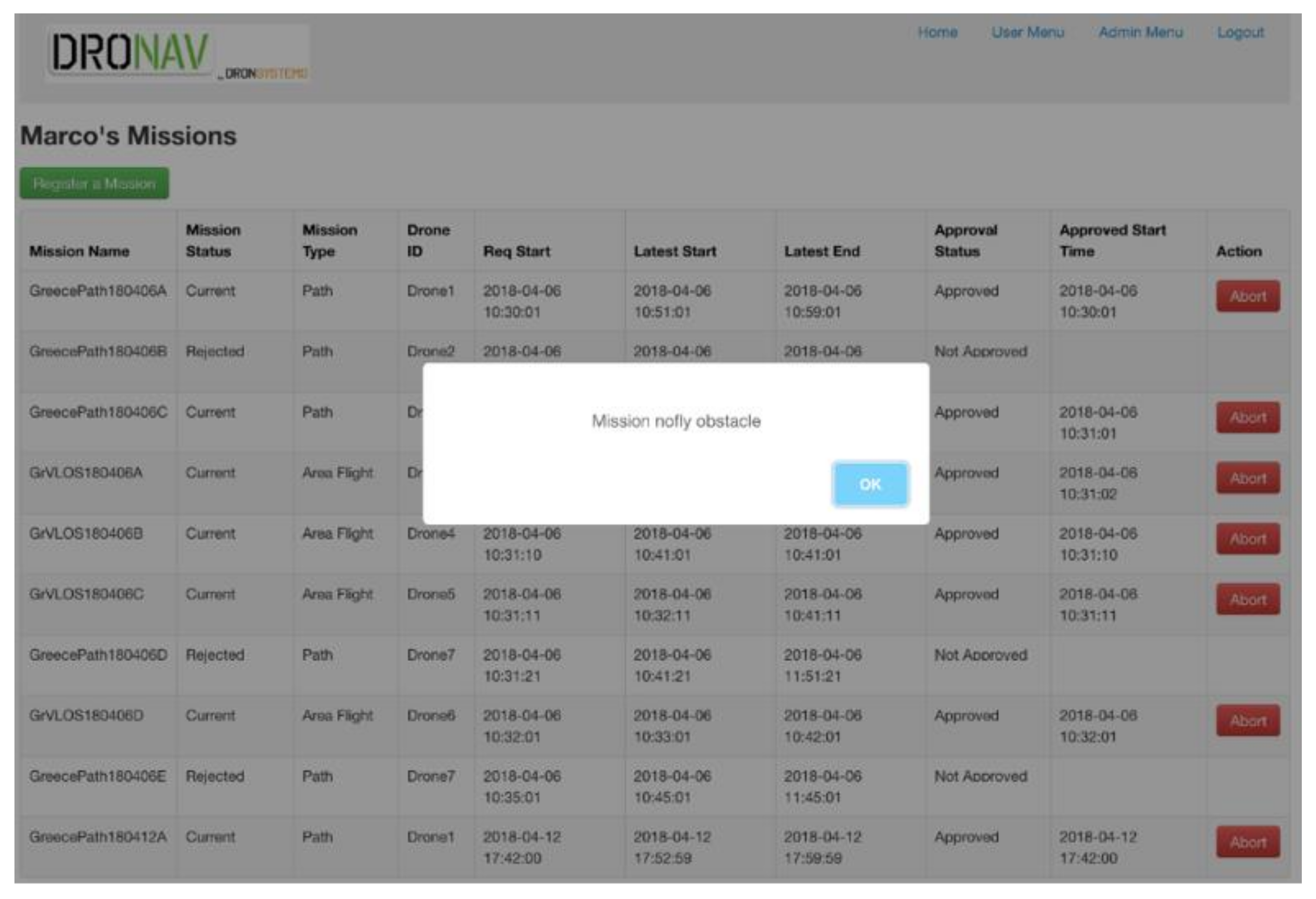
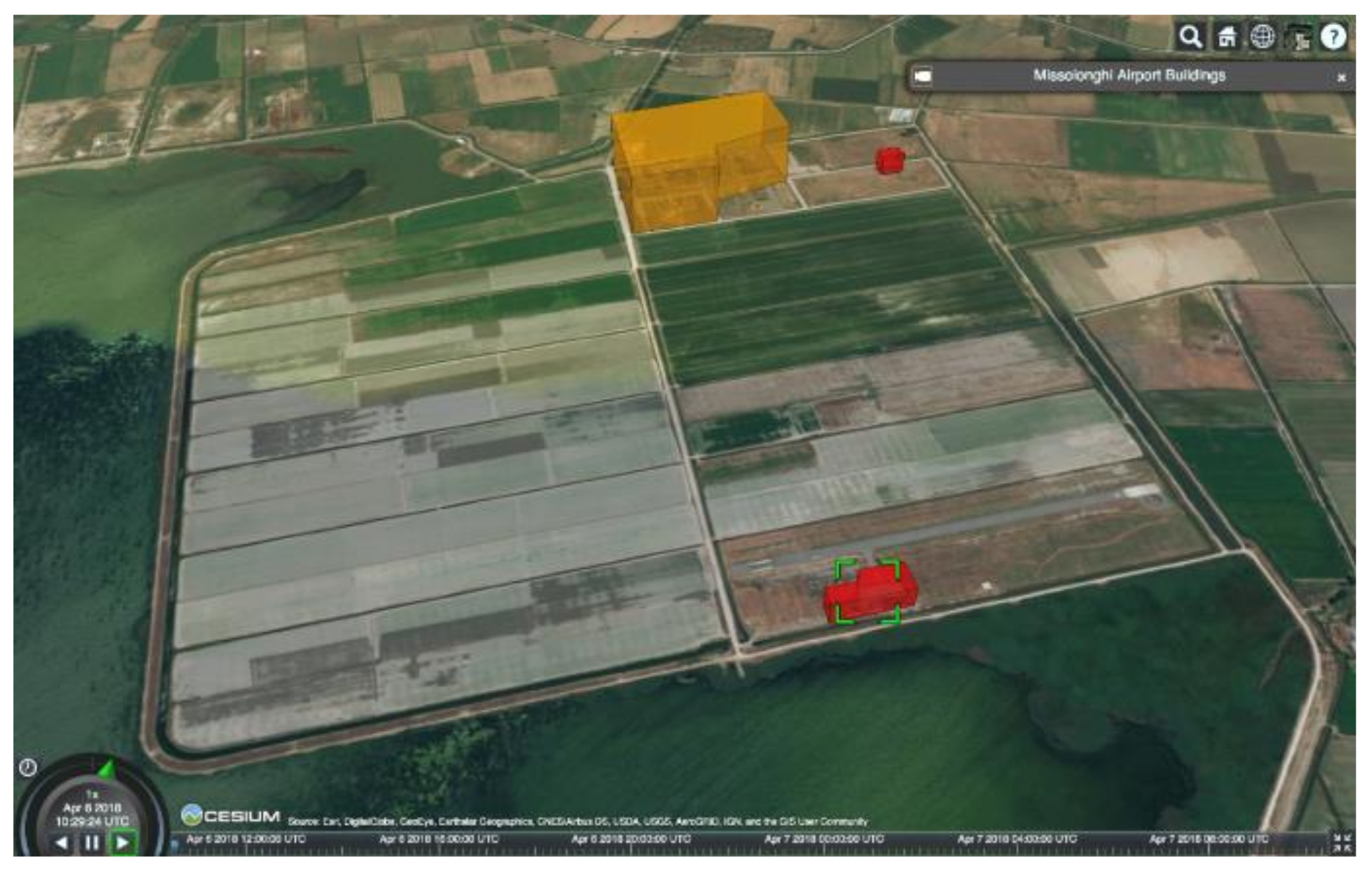
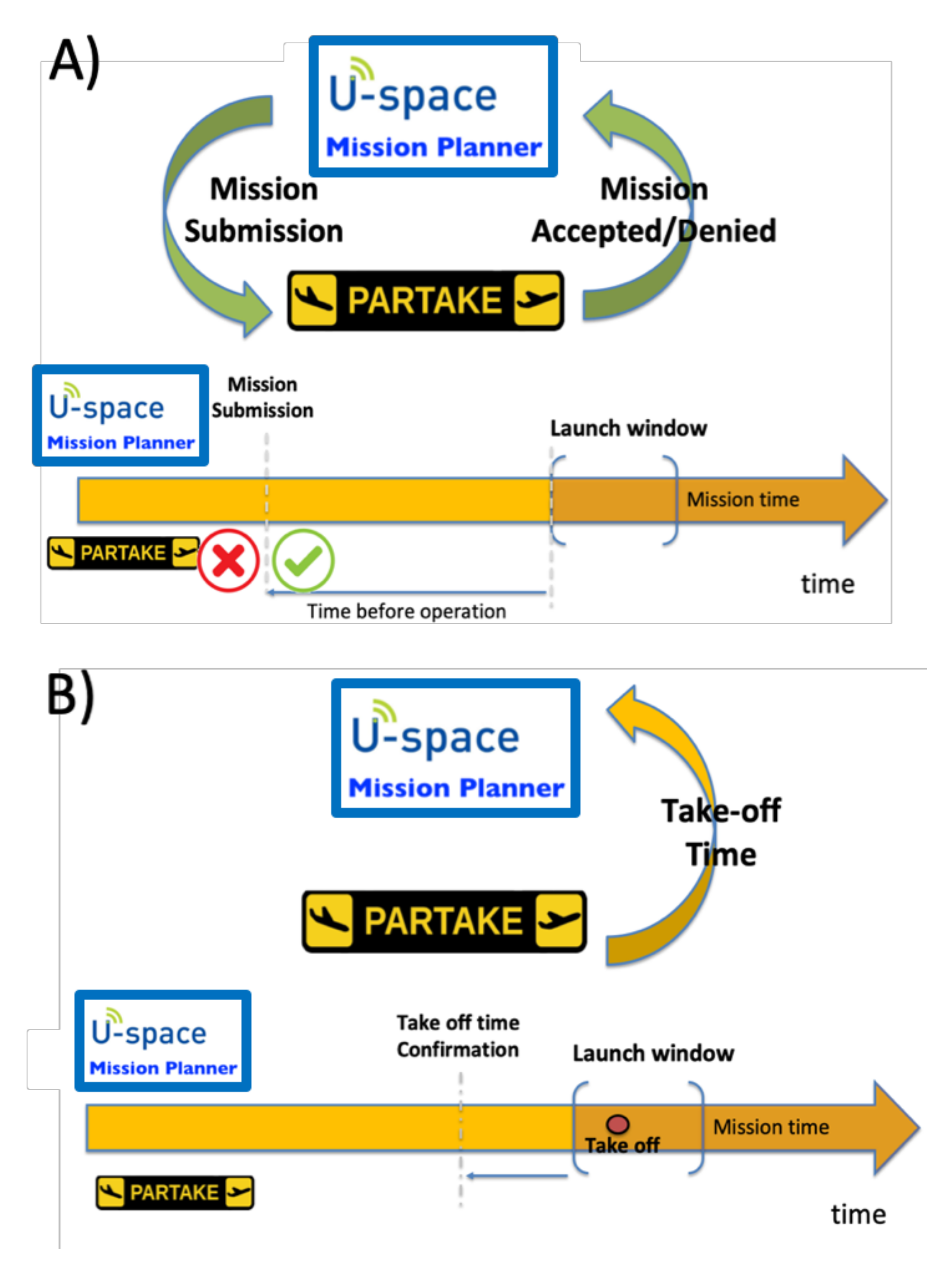
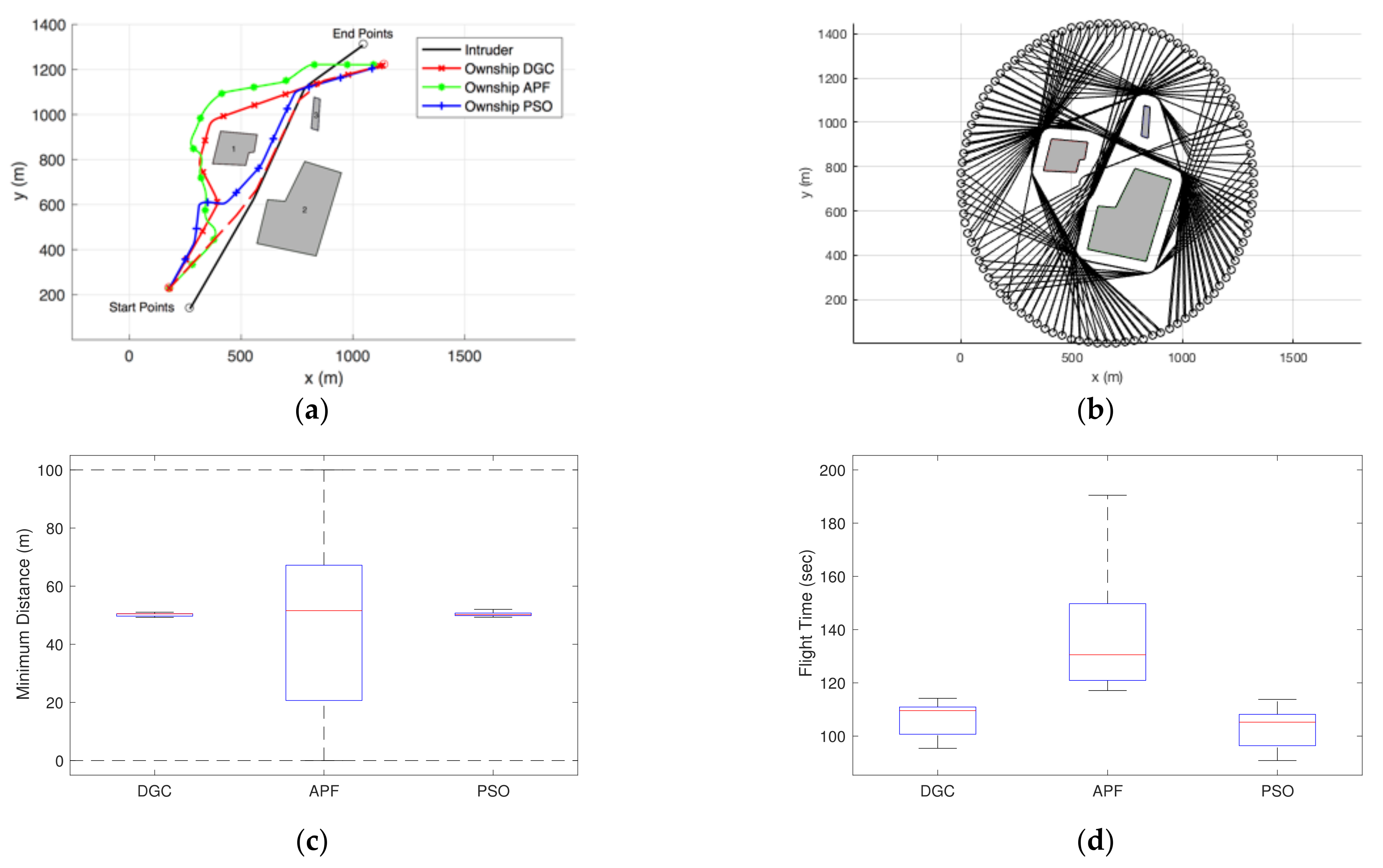
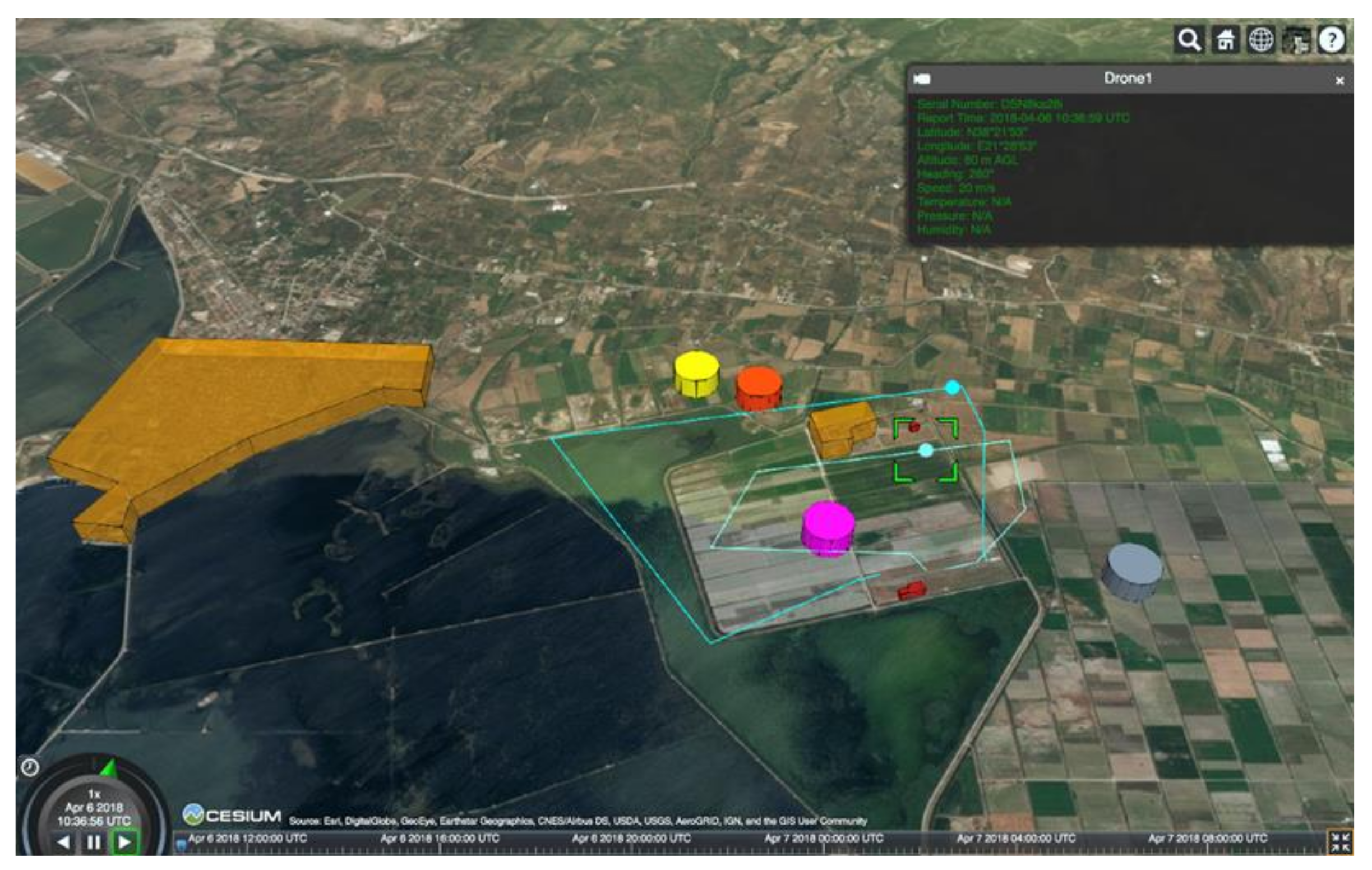
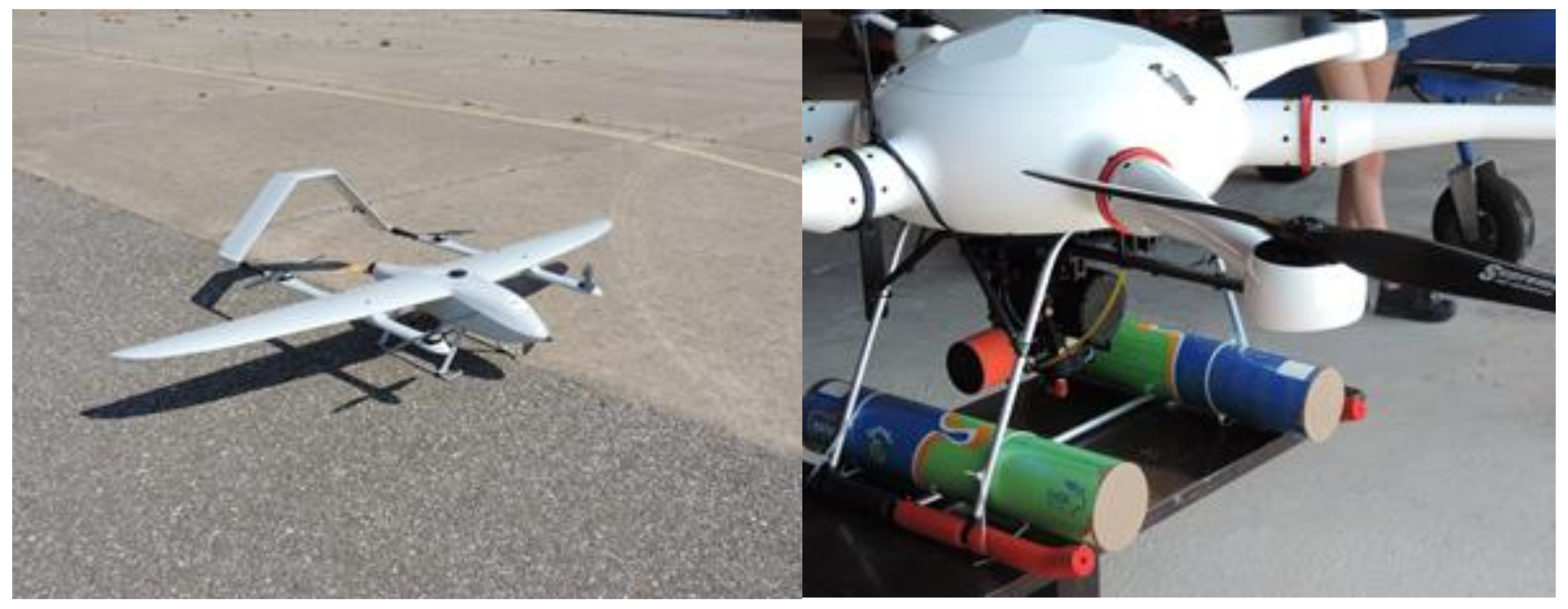
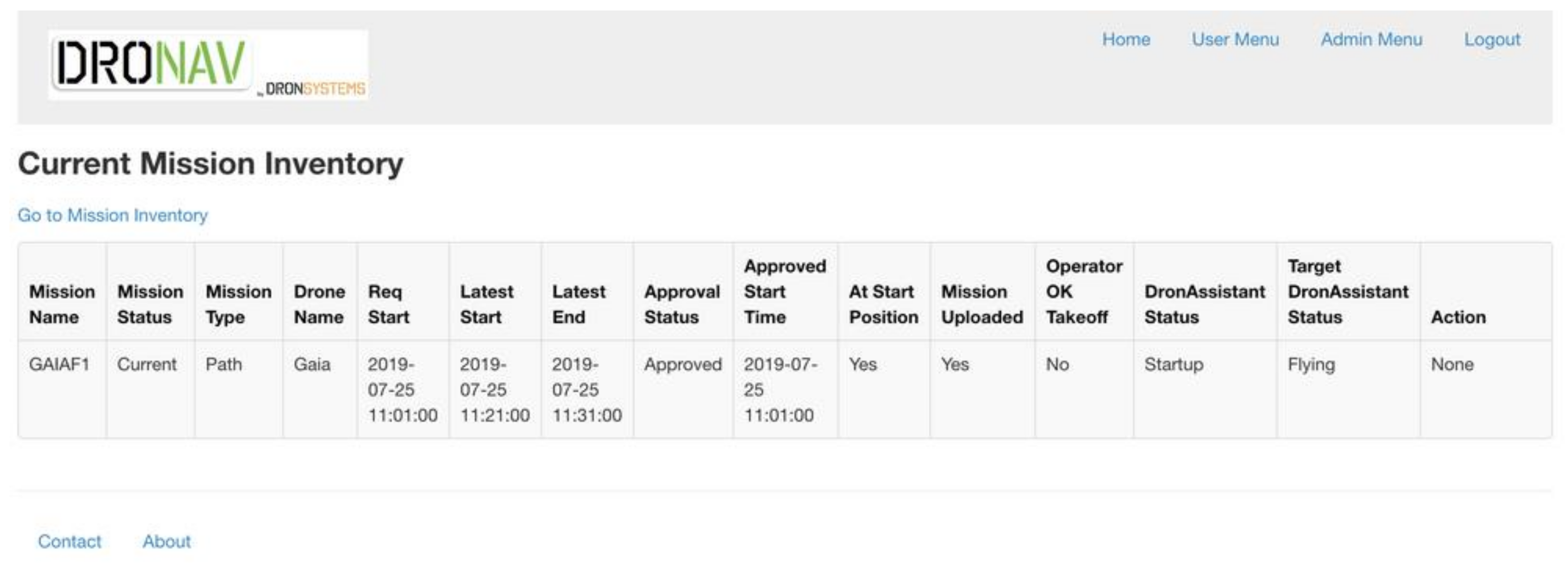
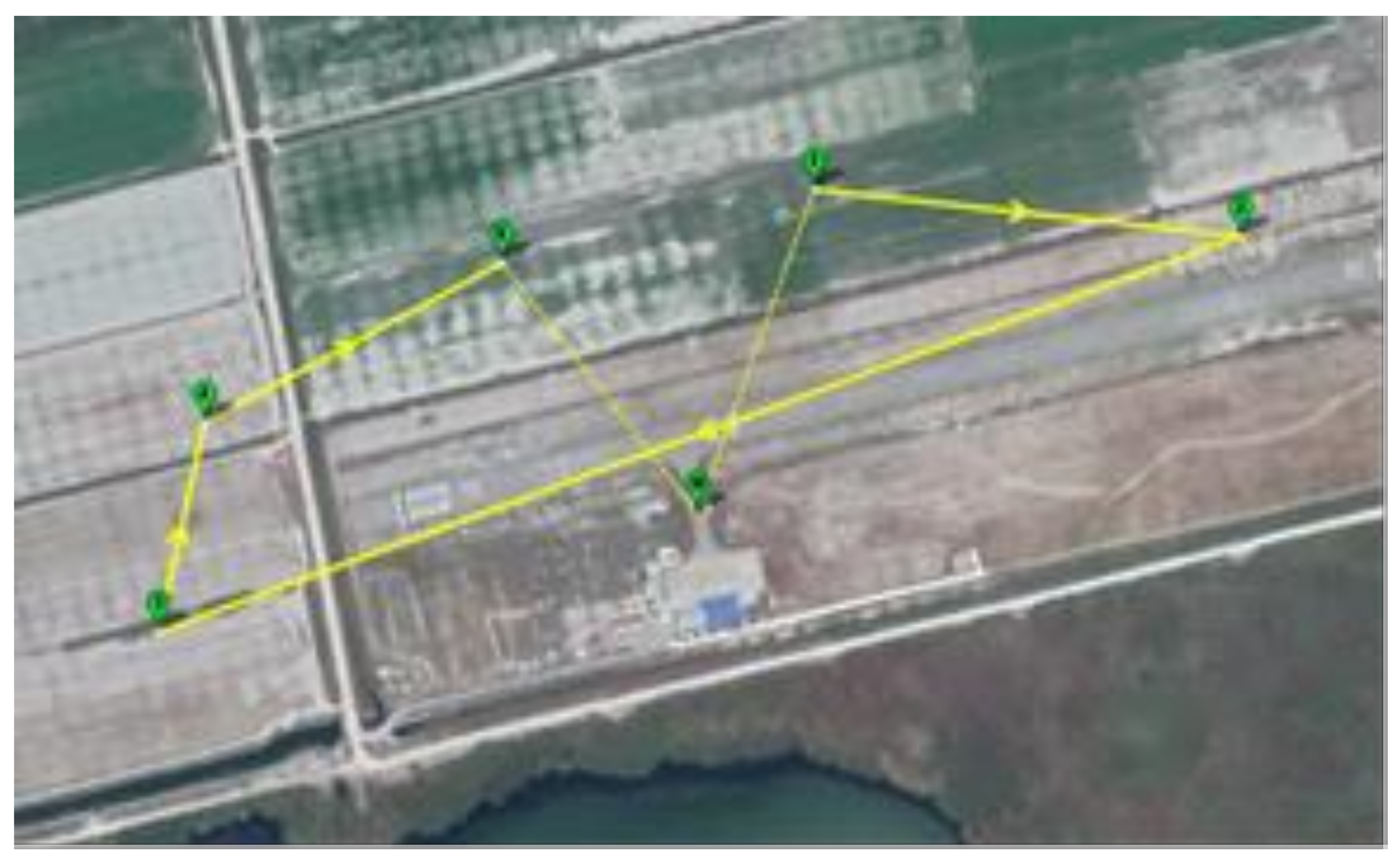
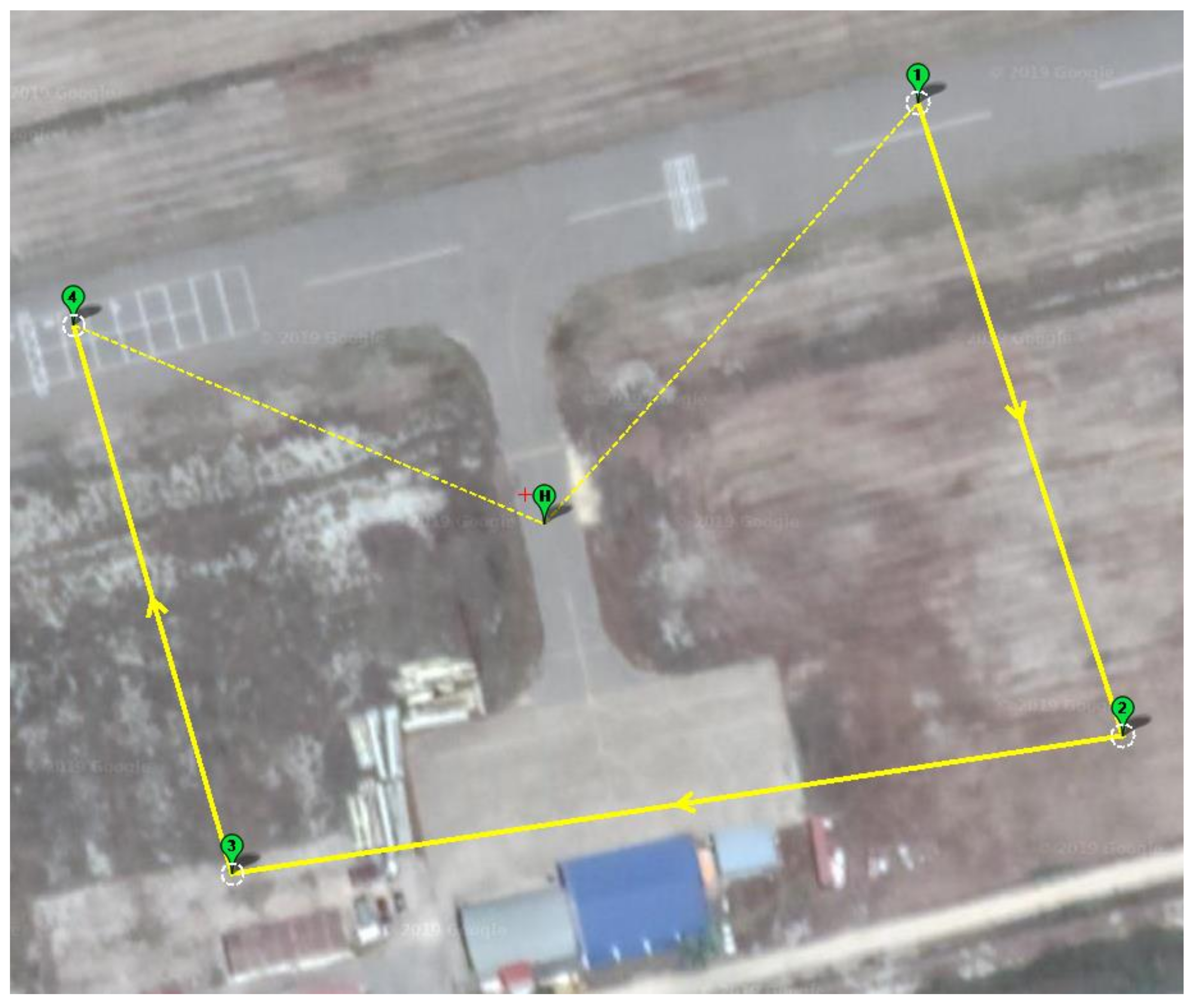
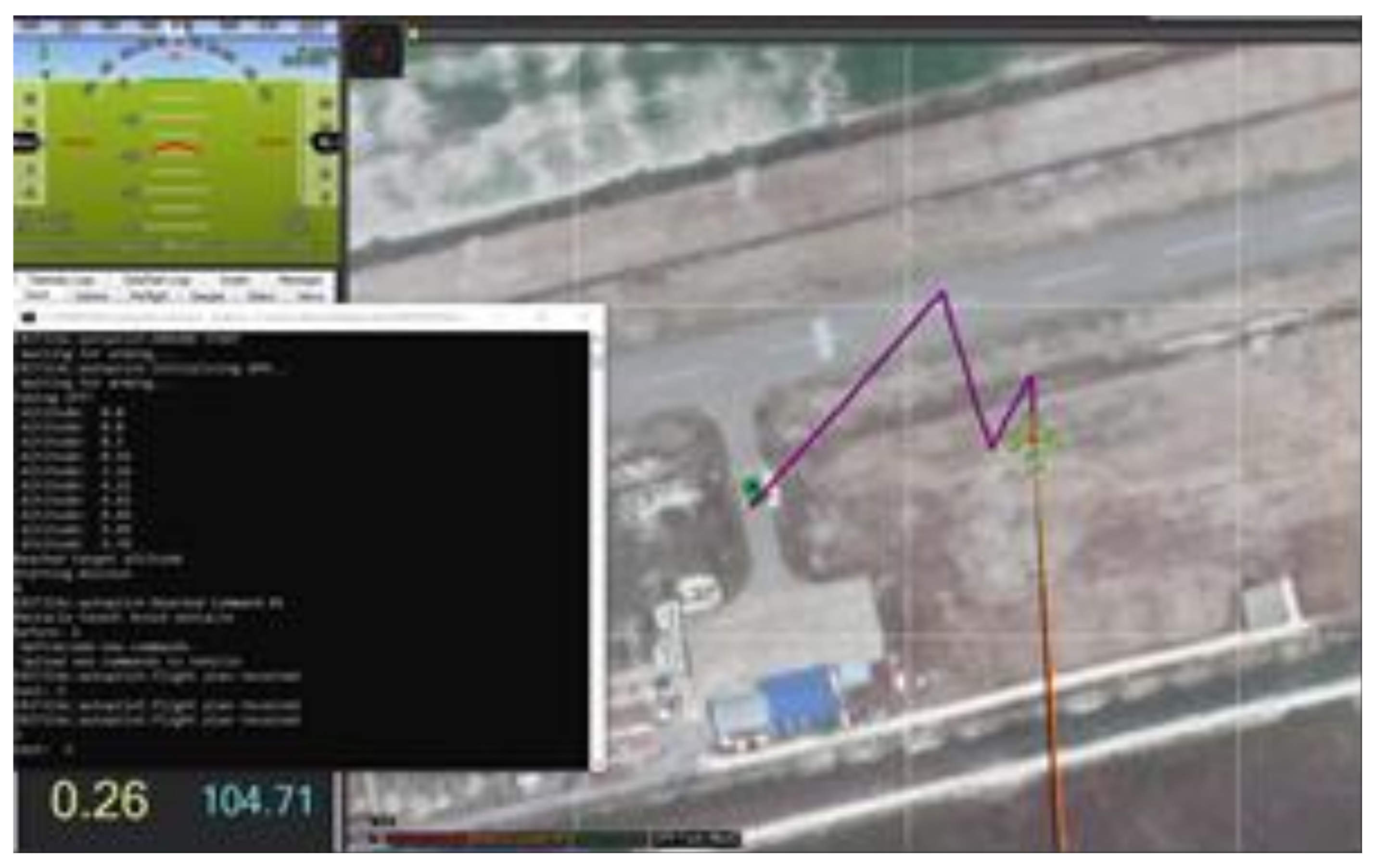

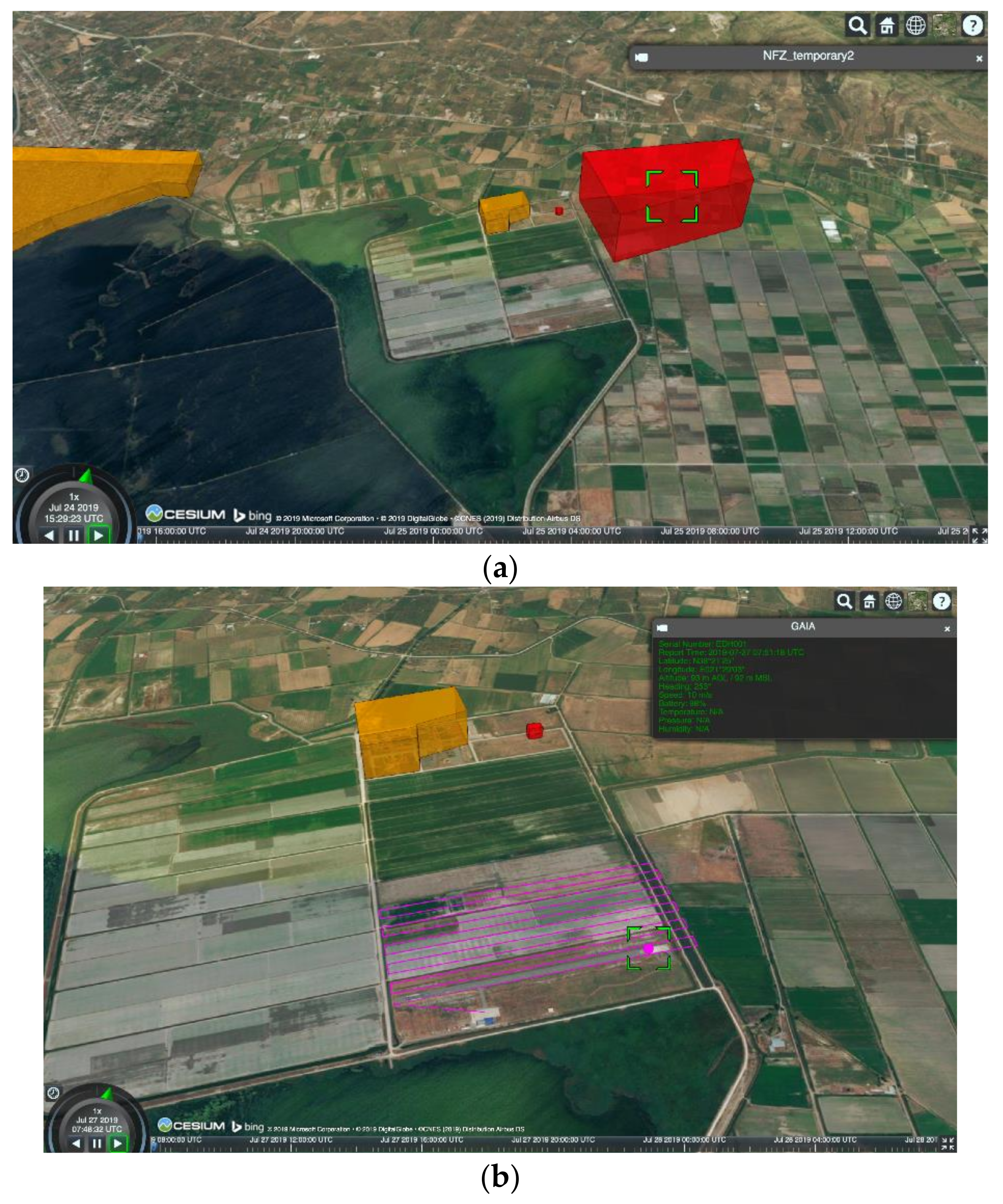
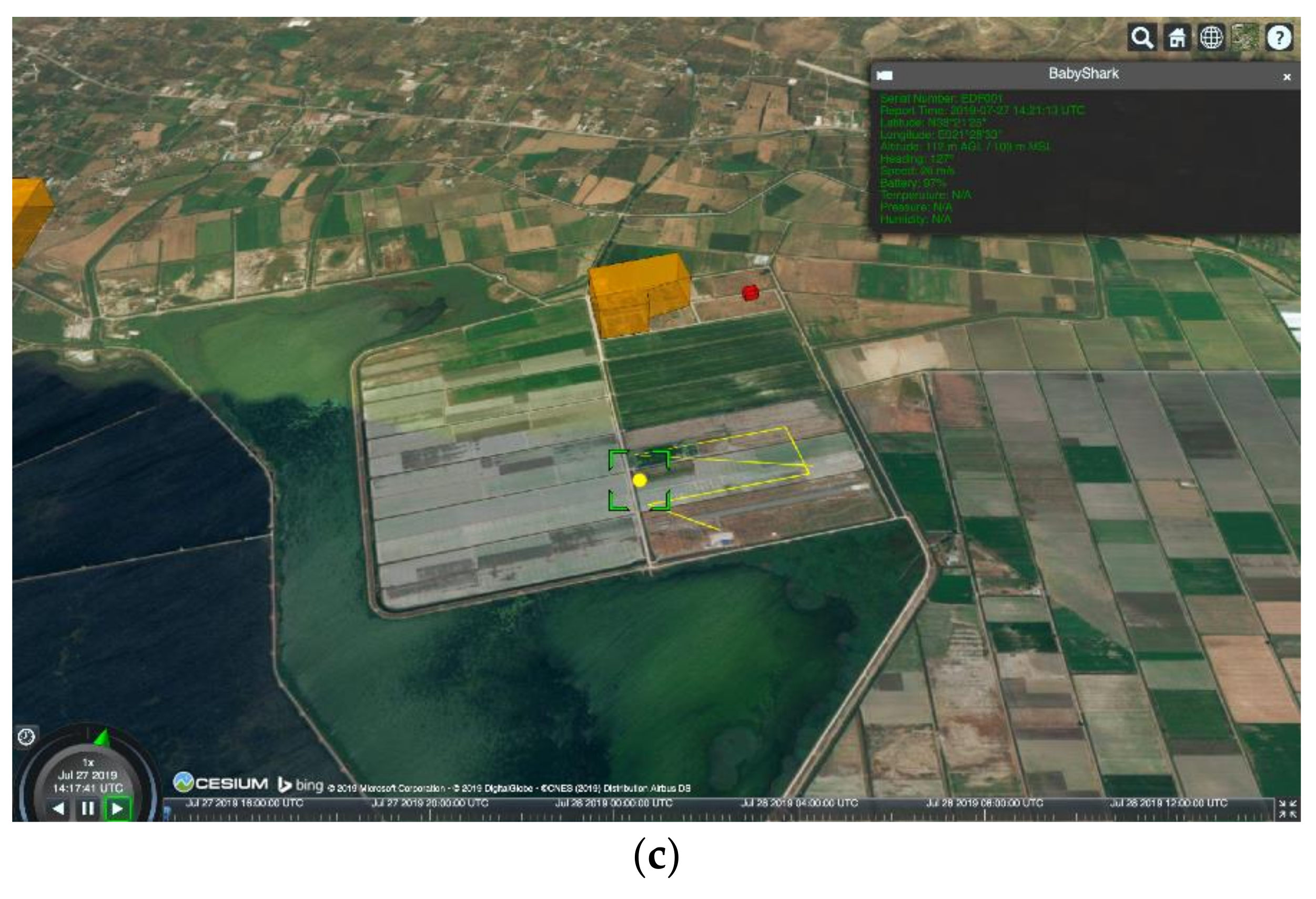
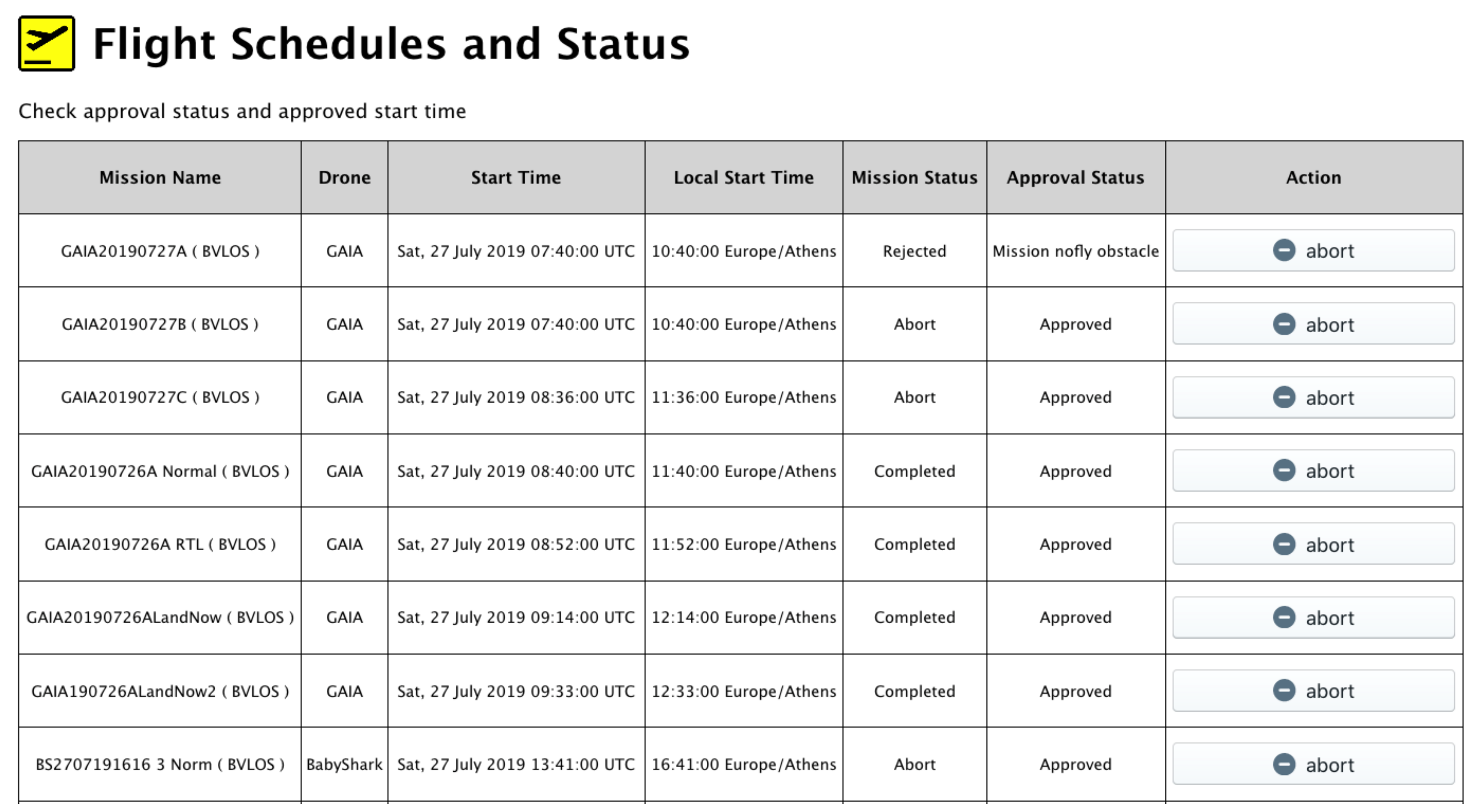
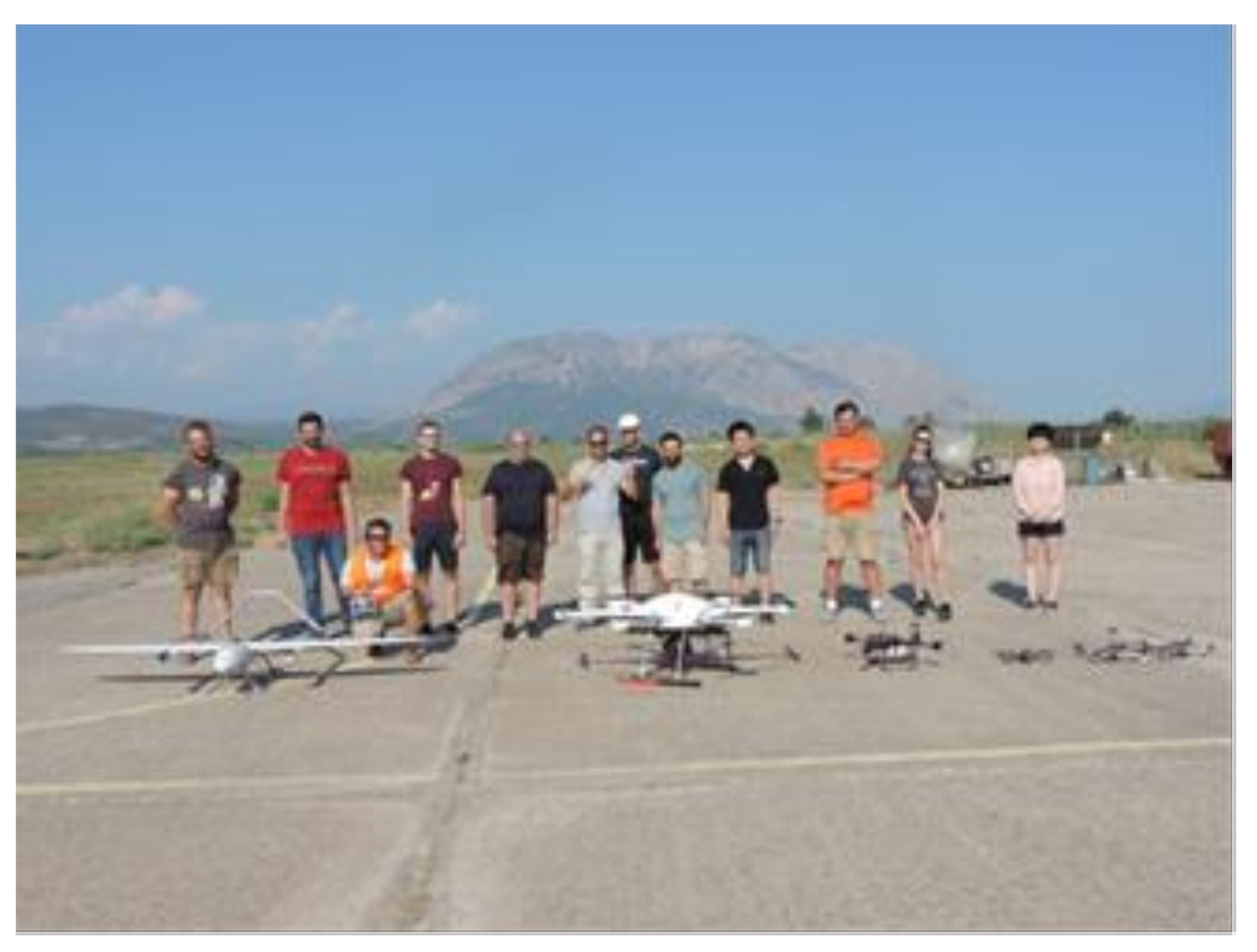
| U1 Services | Main Expected Benefits/Usefulness (e.g., Gain Time, Improve Efficiency, Avoid Intrusion | Main Potential Issues (e.g., Interoperability, Accuracy, Time Criticality, Readability) | |
|---|---|---|---|
| U1 services | E-registration | Full e-registration of vehicles both on online database and on drone, with RF beacon (for recreational users and commercial users operating in VLOS) or DronAssistant (for commercial BVLOS). | Recreational users will remain complacent and will not register their assets without adequate enforcement |
| E-identification | RF beacon, 2.4 GHz, encrypted | Compatibility of versions from different vendors. Relatively short range | |
| Pre-tactical geofencing | Automated/in combination with ATC. Implemented also via simulation, which cancels each mission that occupies a non-flying volume or NOTAM | Need to assess automation for large number of drones/services | |
| U1 capabilities | E-identification | Via RF beacon, 2.4 GHz, encrypted. | Interoperability; congested frequency; low range |
| On-drone geofencing | Alert to operator for the case of recreational drone with RF Beacon. | GNSS accuracy and availability | |
| Security | Data encrypted in motion. | Bandwidth imposes restrictions on the technology used | |
| Telemetry | Transferred both by RF Beacon and DronAssistant Flight Director. | Connection availability and stability | |
| Command & control | Redundant: it makes use of cellular network but ultimately relies on onboard decision making via mission flight director. | Not identified at the moment | |
| Communication, navigation and surveillance | Provided by DronAssistant, in conjunction with DroNav. | Only a limited number of assets have been tested; scalability may present additional requirements | |
| Operations management | Managed by DroNav. | Extended operations may present additional challenges | |
| U2 Services | Main Expected Benefits/Usefulness (e.g., Gain Time, Improve Efficiency, Avoid Intrusion | Main Potential Issues (e.g., Interoperability, Accuracy, Time Criticality, Readability) | |
|---|---|---|---|
| U2 services | Tactical geofencing | Automated on DroNav-DronAssistant and in combination with ATC/Hellenic Civil Aviation Authority. | GNSS Availability and reliability. Timely Database updates |
| Emergency Management | Possibility to give emergency landing command via cellular network and other options open to implementation under civil aviation authority request, including automated commands that can be given by the DronAssistant with no need for a communication link with the ground. | Multiple hardware failures may prevent operators from addressing potential issues | |
| Strategic de-confliction | In-house tools will be used as a webservice for drone operators detecting potential conflict with other missions operating in the same airspace and mitigating them, applying a time departure shift inside the launch window interval assigned by the ecosystem manager. Additionally, synthetic traffic will be injected in this service in order to simulate several operators acting in the same airspace | Strategic deconflicting service is based on an API webservice ready to be integrated in any mission planner, ensuring interoperability. The ID of the missions under conflict is kept transparent to operators ensuring confidentiality. The strategic deconflicting service allows the airspace manager to filter just the missions operating in a given airspace block, allowing a distributed deployment of the deconflicting tool (those missions operating in several airspace blocks are recorded in the different databases associated to each block). | |
| Weather information | Integrated into DroNav and automatically checked for the specific drone model used. | Accurate information available only at either the ground level or higher levels. | |
| Tracking | Via DronAssistant, via cellular network. A future option includes satellite comms when cellular signal is too weak or non-existent. | Availability, bandwidth and reliability of the network; hardware failure; satcom remains expensive | |
| Flight planning management | On DroNav cloud. | Not identified at the moment | |
| Monitoring | DroNav monitors what reported by DronAssistant. | Not identified at the moment | |
| Traffic information | Cooperative General Aviation (GA) detected by DronAssistant. Non-cooperative GA submits a temporary NFZ via user friendly DroNav interface. Data detected by ground radar might be fused into DroNav database. ATC has full situation awareness, and it can both give instructions to drone operators and eventually (if wanted) commands to drones (via DronAssistant). PARTAKE tool will strategically mitigate/reject all missions in conflict with GA. | Not all GA assets activate Mode S on which DronAssistant relies. Low-level radar coverage from outside ATZs is limited. ATC with remote ATZ responsibility at the moment are addressed on a case-by-case basis | |
| Drone AIM | CAA will provide NOTAMS and no-fly zone description, while DronNAV will incorporate information about fixed obstacles. Databases provide integrated fixed obstacles location, mitigating missions in conflict. | On-board processing power limitations and channel bandwidth force a choice between accuracy and the size of the area of operations | |
| Procedural interfaces ATC | ATC has access to DroNav systems, both in terms of flights schedule and status. | Learning curve for ATCOs and standardisation of messages, phraseology, qualifications | |
| Legal recording | Data reported by DronAssistant is stored | Not identified | |
| Accident and incident reporting | Sections on DroNav portal. | Not identified | |
| Digital Logbook | Stored on DroNav backend cloud. | Not identified | |
| Geographic information | Digital elevation model included in DroNav, altitude of the drone (via DronAssistant) both in AGL and MSL. Any further information of any shape can be added, submitting it to DroNav and with the data also stored on DronAssistant. | At the moment, DA relies on GNSS altitude. | |
| Flight plan preparation/optimization assistance | In the current version of EuroDRONE system, waypoints are not modified when a flight plan is submitted, but DroNav, interacting with in house UTM tools, can anticipate or postpone the take-off time respect to the one submitted by the operator in order to approve a flight plan that is otherwise rejected due to conflicts with other flights. | Current models provide a conflict free take-off time 5 s after the submission of the mission, ensuring an acceptable response time.<break/><break/>Beyond those that are being addressed, not identified at the moment | |
| U2 capabilities | Tracking | Via DronAssistant, via cellular network. A future option includes satellite comms when cellular signal is too weak or non-existent. | Beyond those that are being addressed, not identified at the moment |
| Emergency recovery | Possibility to give emergency landing command via cellular network and other options open to implementation under civil aviation authority request, including automated commands that can be given by the DronAssistant with no need for a communication link with the ground. | Beyond those that are being addressed, not identified at the moment | |
| U3 Services | Main Expected Benefits/Usefulness (e.g., Gain Time, Improve Efficiency, Avoid Intrusion | Main Potential Issues (e.g., Interoperability, Accuracy, Time Criticality, Readability) | |
|---|---|---|---|
| U3 services | Emergency Management | As in U2 | Beyond those that are being addressed, not identified at the moment |
| Dynamic geofencing | If a new NFZ is added while drone is already airborne, it is pushed up to DronAssistant and automated path modification can be implemented. | Reliability and availability of GNSS signal; no guarantee that all assets will have the latest update or be compatible | |
| Tactical de-confliction | If a new NFZ (associated with a non-cooperative GA) is added while drone already airborne, it is pushed up to DronAssistant and automated path modification can be implemented. | A range of issues, mostly stemming from interoperability, compatibility and hardware/software reliability | |
| Tracking | As in U2 | As in U2 | |
| Monitoring | As in U2 | As in U2 | |
| Traffic information | As in U2 | Non-cooperative traffic can only be addressed through technology which is not yet mature enough to be recommended | |
| Drone AIM | HCAA will provide NOTAMS and no-fly zone description, while DronNAV will incorporate information about fixed obstacles and PARTAKE will take into account while cancelling missions that interact with them. | ||
| Collaborative interfaces ATC | As in U2 | Learning curve for ATCOs and standardisation of messages, phraseology, qualifications | |
| Dynamic capacity management | First implementation involves use of in-house UTM tools (UTM) to modify take off-times so that mission plans that have been rejected due to interference with other paths are approved. | PARTAKE service is able to map and classify<break/>the missions submitted according to the section of the airspace where they will be executed, knowing the capacity of each airblock. | |
| U3 capabilities | V2V | DronAssistant to DronAssistant. | Technology only works with compatible assets, despite most manufacturers including the relevant comm channels (such as 2.4/5GHz), no single standard on utilisation. Low range and high speed will limit Total Reaction Time to unacceptable levels |
| Detect & avoid | Implemented on DronAssistant, detecting cooperative intruders (GA) and executing onboard collision resolution algorithms, then pushed and executed by the drone autopilot. Radar to detect fixed or slowly moving non-cooperative obstacles not in database might be added at the end of the EuroDRONE activity. | Low-level radar coverage: limited on-board processing power is likely to restrict the number of assets which could be safely managed without standardised protocols | |
| V2I | DroNav-DronAssistant-DroNav. | Availability and reliability of the network; weather and landscape affect long- and medium-range comms; interference on busy frequencies in congested areas | |
Publisher’s Note: MDPI stays neutral with regard to jurisdictional claims in published maps and institutional affiliations. |
© 2022 by the authors. Licensee MDPI, Basel, Switzerland. This article is an open access article distributed under the terms and conditions of the Creative Commons Attribution (CC BY) license (https://creativecommons.org/licenses/by/4.0/).
Share and Cite
Lappas, V.; Zoumponos, G.; Kostopoulos, V.; Lee, H.I.; Shin, H.-S.; Tsourdos, A.; Tantardini, M.; Shomko, D.; Munoz, J.; Amoratis, E.; et al. EuroDRONE, a European Unmanned Traffic Management Testbed for U-Space. Drones 2022, 6, 53. https://doi.org/10.3390/drones6020053
Lappas V, Zoumponos G, Kostopoulos V, Lee HI, Shin H-S, Tsourdos A, Tantardini M, Shomko D, Munoz J, Amoratis E, et al. EuroDRONE, a European Unmanned Traffic Management Testbed for U-Space. Drones. 2022; 6(2):53. https://doi.org/10.3390/drones6020053
Chicago/Turabian StyleLappas, Vaios, Giorgos Zoumponos, Vassilis Kostopoulos, Hae In Lee, Hyo-Sang Shin, Antonios Tsourdos, Marco Tantardini, Dennis Shomko, Jose Munoz, Epameinondas Amoratis, and et al. 2022. "EuroDRONE, a European Unmanned Traffic Management Testbed for U-Space" Drones 6, no. 2: 53. https://doi.org/10.3390/drones6020053
APA StyleLappas, V., Zoumponos, G., Kostopoulos, V., Lee, H. I., Shin, H.-S., Tsourdos, A., Tantardini, M., Shomko, D., Munoz, J., Amoratis, E., Maragkakis, A., Machairas, T., & Trifas, A. (2022). EuroDRONE, a European Unmanned Traffic Management Testbed for U-Space. Drones, 6(2), 53. https://doi.org/10.3390/drones6020053









